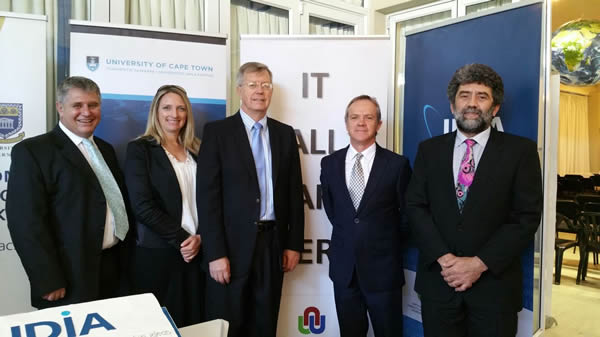IT @ NWU has a new vision for the relationship between IT and the University’s researchers. IT wants to help accelerate research discovery through provisioning of relevant technology, infrastructure, and support. Boeta Pretorius, Chief IT Director says: “Research has been mentioned in the IT strategy for many years, but in 2015 we’re actually going to do something about the way we support our researcher”. So moving from words to action, in the past three months IT has done the following:
- added an eResearch specialist to their staff complement,
- joined conversations about an African Research Cloud together with other prominent research institutes in South Africa and abroad, and
- obtained approval for NWU to feature as founding partner of a South African based institute that will be aimed at research in data intensive sciences.
These steps are the first towards establishing an eResearch Initiative at the North-West University from an IT perspective. Other eResearch partners are also gearing up to embrace technology in research support.
According to Mrs Elsa Esterhuizen, director of Potchefstroom Campus Library Services, eResearch highlights the importance of dovetailing between the various role-players. The Library Services do not only provide access to accredited information sources, but also training and support in the use of research tools. The Research Commons allows exclusive access to postgraduates and researchers. This collaborative hub offers relevant infrastructure enhancing the research process. Another strategic initiative from the Library is the establishment of Boloka, the NWU Institutional Repository where the NWU research outputs are showcased, more visible and online accessible.
But what does eResearch entail?
Although the focus of eResearch is often on the cyberinfrastructure, Australia’s Monash University eResearch Centre classifies eResearch capabilities under the 6 C’s: Collect, Compute, Comprehend, Collaborate, Communicate, and Customise.
Collection refers to the capturing, storage, and management of research data. Data can be generated by research equipment such as microscopes, next generation sequencers, or high performance computers, or through online surveys, and of course even in paper format. Data has to be managed throughout the lifecycle of a research project and thereafter. Good research data management practices are essential for reproducible research and enables researchers to share and reuse data. Role players from an institutional point of view include IT (physical storage and data transfer) and Library Services (development of research data management plans), as well as Research Support (focussing on compliance with funders’ data management requirements).
Although the Compute capability is typically well-developed within research areas such as physics, engineering, and chemistry, data volumes have increased exponentially in various other disciplines including genomics, medicine, and humanities amongst others. Increased data sizes combined with a need for integration of diverse data sets and other factors, have increased the computing requirements in these fields too. Access to adequate high performance computing resources (hardware and expertise) is critical for modelling, simulations, and data processing. Collaborations between traditionally compute intensive research units, IT, national and international infrastructure providers is of utmost importance to ensure development of appropriate computing resources for research purposes.
It is well understood that the human brain can interpret complex datasets better through appropriate graphical or visual displays than in textual or numerical format. Comprehension of research datasets can be facilitated through the use of visualisation facilities such as the Highly Immersive Visualisation Environment at University of the Western Cape, the Scientific Computing group’s visualisation studio at the University of Cape Town, or the CAVE2 at Monash University. Visualisation of research datasets provides very interesting and complex challenges and is an active topic of research across the globe. Not only does it involve IT, but also subject specific researchers, computer scientists, engineers, arts, and software developers.
eResearch all about collaborative training initiatives
Thinking about large international collaborative research projects such as the (SKA) Square Kilometre Array or Human, Heredity, and Health in Africa (H3Africa) one soon realises that new technologies and methodologies are required to support the Collaboration aspect of these project. Virtual meetings, collaborative document editing, collaborative software development, and collaborative training initiatives are only a few aspects where eResearch comes to play.
Throughout the lifecycle of research projects, data is generated (and managed), analysed and visualised. The stakeholders including the funders, fellow researchers and collaborators, potential students, policy makers and governments need to be informed of the progress, process, and outcomes. Research Communication has also changed over the last few years. The use of social media and Web 2.0 - Twitter, Face- Book, blogs, and discussion forums are now included.
These communication mediums have been popularised alongside electronic journals to reduce the time to access new information and create new opportunities for collaboration and knowledge sharing.

W v Belkum, A vd Walt, F v Niekerk, B Pretorius,
P Enslin
